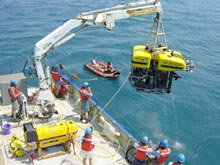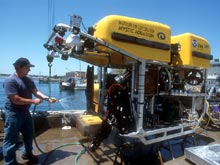
The science team and ship's crew recover the Hercules and prepare to place it on the fantail of the R/V Knorr, while a National Geographic camera team films the operation from a small boat. Click image for larger view.
Black Sea Expedition 2003
July 21 - August 7, 2003
LTJG Jeremy B. Weirich
Marine Archaeologist and Hydrographer
NOAA Office of Ocean Exploration
Dr. Robert Ballard's Institute for Exploration (IFE) ![]() returned to the Black Sea this summer to continue to explore ancient shipwrecks and possible man-made settlements off the coast of Turkey. This time,the diverse research team of scientists, archaeologists and engineers brought two new types of advanced technology with them. One investigated the sea floor remotely, while another broadcasted the results live to the world.
returned to the Black Sea this summer to continue to explore ancient shipwrecks and possible man-made settlements off the coast of Turkey. This time,the diverse research team of scientists, archaeologists and engineers brought two new types of advanced technology with them. One investigated the sea floor remotely, while another broadcasted the results live to the world.
The Black Sea is unique in that there is little to no oxygen below a few hundred meters. This cold, anoxic water combines with little bottom currents to create ideal conditions for preserving organic matter, such as the ancient wooden shipwrecks discovered during Dr. Ballard's previous missions. This summer, they used the new ROV (remotely operated vehicle) Hercules, which was specially designed to conduct underwater archaeological surveys here. It is equipped with a force feedback manipulator, advanced high-definition imagery, and a sediment-removal system. This unique vehicle worked in tandem with the ROV Argus, which served as a lighting and imagery platform.

The Hercules ROV was specially designed to conduct underwater archaeological surveys at dive sites in the Black Sea. Click image for larger view.
In addition, this summer's expedition was broadcasted in real time using an innovative telecommunications system called Inner Space. Developed by EDS and VBrick, it transmitted images from the ship via satellite to the University of Rhode Island and Mystic Aquarium, and was then distributed worldwide. Specific locations with Internet II capabilities could view live streaming video 24 hrs/day, and regular updates were presented on a regular Internet Web page.

